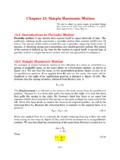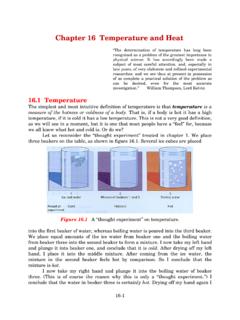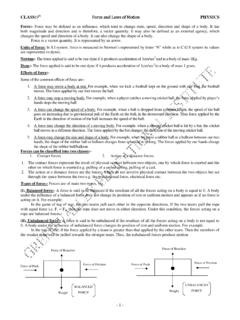Transcription of Chapter 6 Newton’s Laws with Friction, and Circular …
1 Chapter 6 Newton s laws with Friction, and Circular motion Friction Whenever we try to slide one body over another body there is a force that opposes that motion . This opposing force is called the force of friction. For example, if this book is placed on the desk and a force is exerted on the book toward the right, there is a force of friction acting on the book toward the left opposing the applied force, as shown in figure Figure The force of friction. The basis of this frictional force stems from the fact that the surfaces that slide over each other are really not smooth at all. The top of the desk feels smooth to the hand, and so does the book, but that is because our hands themselves are not particularly smooth. In fact, if we magnified the surface of the book, or the desk, thousands of times, we would see a great irregularity in the supposedly smooth surface, as shown in figure Figure The smooth surfaces of contact that cause frictional forces.
2 As we try to slide the book along the desk these little microscopic chunks of the material get in each others way, and get stuck in the mountains and valleys of the other material, thereby opposing the tendency of motion . This is why it is difficult to slide one body over another. To get the body into motion we have to break off, or ride over, these microscopic chunks of matter. Because these chunks are microscopic, we do not immediately see the effect of this loss of material. Over a long period of time, however, the effect is very noticeable. As an example, if you observe any step of a stairway, which should be flat and level, you will notice that after a long period of time the middle of the stair is worn from the thousands of times a foot slid on the step in the process of walking up or down the stairs. This effect occurs whether the stairs are made of wood or even marble.
3 The same wearing process occurs on the soles and heels of shoes, and eventually they must be replaced. In fact the walking process can only take place because there is friction between the shoes and the ground. In the process of Chapter 6 Newton s laws with Friction, and Circular motion 6-2 walking, in order to step forward, you must press your foot backward on the ground. But because there is friction between your shoe and the ground, there is a frictional force tending to oppose that motion of your shoe backward and therefore the ground pushes forward on your shoe, which allows you to walk forward, as shown in figure Figure You can walk because of friction. If there were no frictional force, your foot would slip backward and you would not be able to walk. This effect can be readily observed by trying to walk on ice. As you push your foot backward, it slips on the ice. You might be able to walk very slowly on the ice because there is some friction between your shoes and the ice.
4 But try to run on the ice and see how difficult it is. If friction were entirely eliminated you could not walk at all. Force of Static Friction If this book is placed on the desk, as in figure , and a small force F1 is exerted to the right, we observe that the book does not move. There must be a frictional force f1 to the left that opposes the tendency of motion to the right. That is, f1 = F1. If we increase the force to the right to F2, and again observe that the book does not move, the opposing frictional force must also have increased to some new value f2, where f2 = F2. If we now increase the force to the right to some value F3, the book just begins to move. The frictional force to the left has increased to some value f3, where f3 is infinitesimally less than F3. The force to the right is now greater than the frictional force to the left and the book starts to move to the right. When the object just begins to move, it has been found experimentally that the frictional force is fs = sFN ( ) where FN is the normal or perpendicular force holding the two bodies in contact with each other.
5 As we can see in figure , the forces acting on the book in the vertical are the weight of the body w, acting downward, and the normal force FN of the desk, pushing upward on the book. In this case, since the acceleration of the book in the vertical is zero, the normal force FN is exactly equal to the weight of the Chapter 6 Newton s laws with Friction, and Circular motion 6-3 Figure The force of static friction. book w. (If the desk were tilted, FN would still be the force holding the two objects together, but it would no longer be equal to w.) The quantity s in equation is called the coefficient of static friction and depends on the materials of the two bodies which are in contact. Coefficients of static friction for various materials are given in table It should be noted that these values are approximate and will vary depending on the condition of the rubbing surfaces. Table Approximate Coefficients of Static and Kinetic Friction for Various Materials in Contact Materials in Contact s k Glass on glass Steel on steel (lubricated) Wood on wood Wood on stone Rubber tire on dry concrete Rubber tire on wet concrete Leather on wood Teflon on steel Copper on steel As we have seen, the force of static friction is not always equal to the product of s and FN, but can be less than that amount, depending on the value of the applied force tending to move the body.
6 Therefore, the force of static friction should be written as fs sFN ( ) where the symbol means equal to, or less than. The only time that the equality holds is when the object is just about to go into motion . Chapter 6 Newton s laws with Friction, and Circular motion 6-4 Force of Kinetic Friction Once the object is placed into motion , it is easier to keep it in motion . That is, the force that is necessary to keep the object in motion is much less than the force necessary to start the object into motion . In fact once the object is in motion , we no longer talk of the force of static friction, but rather we talk of the force of kinetic friction or sliding friction. For a moving object the frictional force is found experimentally as fk = kFN ( ) and is called the force of kinetic friction. The quantity k is called the coefficient of kinetic friction and is also given for various materials in table Note from the table that the coefficients of kinetic friction are less than the coefficients of static friction.
7 This means that less force is needed to keep the object in motion , than it is to start it into motion . We should note here, that these laws of friction are empirical laws , and are not exactly like the other laws of physics. For example, with Newton s second law, when we apply an unbalanced external force on a body of mass m, that body is accelerated by an amount given by a = F/m, and is always accelerated by that amount. Whereas the frictional forces are different, they are average results. That is, on the average equations and are correct. At any one given instant of time a force equal to fs = sFN, could be exerted on the book of figure , and yet the book might not move. At still another instance of time a force somewhat less than fs = sFN, is exerted and the book does move. Equation represents an average result over very many trials. On the average, this equation is correct, but any one individual case may not conform to this result.
8 Hence, this law is not quite as exact as the other laws of physics. In fact, if we return to figure , we see that it is not so surprising that the frictional laws are only averages, because at any one instant of time there are different interactions between the mountains and valleys of the two surfaces. When two substances of the same material are slid over each other, as for example, copper on copper, we get the same kind of results. But if the two surfaces could be made perfectly smooth, the frictional force would not decrease, but would rather increase. When we get down to the atomic level of each surface that is in contact, the atoms themselves have no way of knowing to which piece of copper they belong, that is, do the atoms belong to the top piece or to the bottom piece. The molecular forces between the atoms of copper would bind the two copper surfaces together. In most applications of friction in technology, it is usually desirable to minimize the friction as much as possible.
9 Since liquids and gases show much lower frictional effects (liquids and gases possess a quality called viscosity - a fluid friction), a layer of oil is usually placed between two metal surfaces as a lubricant, which reduces the friction enormously. The metal now no longer rubs on metal, but rather slides on the layer of the lubricant between the surfaces. For example, when you put oil in your car, the oil is distributed to the moving parts of the engine. In particular, the oil coats the inside wall of the cylinders in the Chapter 6 Newton s laws with Friction, and Circular motion 6-5 engine. As the piston moves up and down in the cylinder it slides on this coating of oil, and the friction between the piston and the cylinder is reduced. Similarly when a glider is placed on an air track, the glider rests on a layer or cushion of air. The air acts as the lubricant, separating the two surfaces of glider and track. Hence, the frictional force between the glider and the air track is so small that in almost all cases it can be neglected in studying the motion of the glider.
10 When the skates of an ice skater press on the ice, the increased pressure causes a thin layer of the ice to melt. This liquid water acts as a lubricant to decrease the frictional force on the ice skater. Hence the ice skater seems to move effortlessly over the ice, figure Figure An ice skater takes advantage of reduced friction. Rolling Friction To reduce friction still further, a wheel or ball of some type is introduced. When something can roll, the frictional force becomes very much less. Many machines in industry are designed with ball bearings, so that the moving object rolls on the ball bearings and friction is greatly reduced. The whole idea of rolling friction is tied to the concept of the wheel. Some even consider the beginning of civilization as having started with the invention of the wheel, although many never even think of a wheel as something that was invented.














